Furries and Fursonas
by R.E. Slater
November 13, 2022
Recently the subject of "Furry" trans-people as arisen in Christian circles - although I'm sure I'm the last one to have heard of this social event, my engagement was less-than-satisfactory with fellow Christians who were running on high red-alert in their own wild mis-assessments on this same issue.
So, I'd like to state for the record my own non-professional Christian perspectives on this hot button issue that many are blowing up out-of-proportion to what they think is there.
A Public Over-Reaction
Yes, in some very small or rare instances within the trans community there are a few overt personal behaviors being observed who are calling themselves "furries" as acts of healthy, self-healing with other similar souls - some of whom may be a trans-person, and some of whom may be deeply conflicted beyond the mere misunderstanding by the general public of what gender "lostness" can mean to those conflicted in their souls who sometimes portray themselves through a custome instead of by some other means like "drag-dressing styles."
Further, my comments here will be to approach this subject as more than an anime type "fan in a furry suit" or in "steampunk" or "medieval" or even as "civil war" re-enactors. I wish to approach the subject of "trans-furries" from more of a psychological / sociological viewpoint. But be aware that this may only apply to those rare few within the furry community (whether trans- or not) by which my sentiments might be helpfully applied to the more general "furry" population who are healthily normal and seeking fellowship not unlike other like-souled individuals when dressing up a movie re-enactors or the more common sports fans we observe on weekends.
What is Gender Lostness?
Transgenders are caught in a no man's land re sexual identity. One way to understand this community in their conflicts for personal identity has been through a very small trend where some few are exploring gender identity by "wearing" gender neutral personas which may provide emotional, mental, or even soul neutrality.
Rather than condemning these "persona-actors" as sin and evil consider these social behaviors as perhaps showing a form of emotional instability via aberrant social behavior whereby a "fursona" might sort out conflicted states of conformity within a gender safe, neutral environment while searching out more deeply held feelings of one's inner self.
Secondly, to those of us on the outside of a trans-gender's inner psycho-social conflicts, we may rightly feel distraught, unnerved, or adverse to any personal or public confrontations with "trans-explorers" as they confront our own personal senses of psycho-social behaviors and self-identity in public displays of decoherence.
My suggestion to you is to go with the flow with as little judgment or confrontation as possible. Your conflict, if externalized to a trans undergoing self-questioning, most likely won't help them - though it will very often provide to them their own justified feelings of self-conflict which they seek to "trans-cend". More likely you will be causing greater self-confirmation to an already dissettled persona in deep conflict with deeply turbulent life feelings and experiences in self-projected, or anticipated, environments of rejection by our many reactionary forms.
Therefore, it is critically important for us - as a non-trans, gender-confirming society - to accept and assist conflicted souls during their times of exploration... not to be judgmental, brutal, bullying, or harmful.
Final Words
To my Christian brothers and sisters, many of us live within our sheltered thoughts of a socio-religious gender conformity which grants an extremely low tolerance for other-difference. Especially when confronting socio-behavioral aberrancy. However, be the one individual in your community to show compassion and consideration to transgender souls who are actively choosing neither a male or female persona.... And remember, these personas are highly different than a bi-sexual's personal perception of themselves.
Finally, the world holds a lot of brokenness to the harms it has brought upon itself over the ages of socio-religious and political civilization development in community with one another. Every living person struggles with something within themselves, their home, their family, their friends and cohorts. There is no "perfect" Eden out there. Racism, hate, bullying, et al, has created wave upon wave of evil in this world. Try not to add to our common social experiences of rejection and brutality. None of us is God. Nor does God need to be "defended" by you, your church, or your beliefs. What God really needs is our responses to love. It is the most highly desired quality in a world of everywhere brokenness. Be love to one another. Be a safe space for healing. Be unlike ourselves and become scented balms of reciprocating fellowships of loving engagement, embrace, and energy.
Blessings,
R.E. Slater
November 13, 2022
* * * * * * *
The use of a "fursona" to explore gender is useful in many ways, including being risk-free in terms of internal discomfort as well as externally. These findings may be significant for people who are looking for a safe way to explore their relationship with their gender.
USI 2020 Honors Symposium - Gender Identity and Fursonas
"A Furry Friend: An Autoethnography on the Relationship
Between Gender Identity and Fursonas."
AbstractTransgender people identify as a gender other than the one assigned to them at birth, whether this is male, female, or something else entirely. Furries are people who have an interest in anthropomorphic animals, and many have a “fursona”, or an animal representation of the self. Furries often use fursonas to reflect a sexual or gender identity. LGBT+ people are a majority in the furry fandom, and there are more transgender people than in the general population [of self-identified fursonas].Given that transgender people are more common in the furry community, research looking into the relationship between gender development and furry identity could yield interesting insights. The following project is an autoethnography done by a trans man who is a furry. His previous and current fursonas were dated and redrawn. Then, these "fursonas" were analyzed based on appearance and the author’s life events at the time, with a focus on his relationship to his gender. The analysis indicates that, not only did his fursonas change with his gender, but that the fursonas themselves were used as a tool for gender exploration. The use of a fursona to explore gender was useful in many ways, including it being risk-free in terms of internal discomfort as well as externally. These findings may be significant for people who are looking for a safe way to explore their relationship with their gender.
1.) Bayda- My first fursona evar. evarevarEVAR. She was just a brown dog with blue eyes and a red scar marking on her eye. Very simple. xD She has a lot of sentimental value to me ;__; ..waaay back when I had no clue what a furry was xD (I might of made her before 4th grade? I'm not sure ;n; I have a lot of un-dated pictures of her and the only one with a date was during 4th grade D: )
2.) Araylenne; "Aray" - Replaced Bayda with a wolf. xDD She also has a rather simple design.. white fur, blue scar markings on both her eyes, blue underbelly, and blue tip of her tail. Aray also has a lot of sentimental value. C":
3.) Spazz ♂ - oh mai gawd. kill it with FIRE xD . 6th grade began my obsession with Starbucks coffee... thus, Spazz was created. He was crazy and was my first mute character. x3 I created him in my I HATE FURRIES stage. ..Soon after he was created, I was told what a furry was and I felt like an idiot, LOL (I SECRETLY HATE WHAT I AM, oh boy)
4.) Madispazz - Male Spazz didn't last for too long xD . Replaced him with a female version ..and got rid of dem crazy eyes o___O. Madispazz is not mute o: oh and.. SCARF.
5.) Spazz / Madispazz ♀ - [CURRENT FURSONA] Spazz is a representation of myself. ...in animal form xD. She has such a simple design.. it's hilarious. ..Spazz isn't mute c: only male Spazz was.
6.) Lulahbe; "Lulah" - a hybrid character! Lulah is a red panda / rabbit creature :3 she was really fun to draw.. but after a while, she just didn't feel right being a fursona. Lulah is now one of my characters :U ..and I draw her as a human xD
7.) Rhasima - not much to say about her, except Rhasima was a representation of my rebellious side xD. she didn't last long as a fursona either :U
8.) Spizz / Sizz - [SIDE FURSONA] Spizz is the girly representation of myself :U being opposite of me in many ways xD. She's a raccoon / red panda creature.. RAINBOOOWSSS ♥ I love rainbows Cx (no homo ♥)
* * * * * * *
Teen 'Furries' on what their costumes may mean to them
article link and short video found here:
A "Furry" is someone who dresses up like an animal to create a different persona for themselves.
"I can understand why people find it weird," says Sophie Robson, aka Cosmo.
"Some people might go for traits they want to see in themselves, or ones they would like.
"It's pretty much having the perfect version of you."
This video was created as part of We Are Bradford - a BBC project with the people of the city to tell the stories which matter to them.
Maisie says wearing the costumes makes "you feel like a different person".
Her mother Lisa Earl said Maisie spends all of her spare time on her sewing machine: "She's completely self-taught.
"I can understand why people find it weird," says Sophie Robson, aka Cosmo.
"Some people might go for traits they want to see in themselves, or ones they would like.
"It's pretty much having the perfect version of you."
This video was created as part of We Are Bradford - a BBC project with the people of the city to tell the stories which matter to them.
* * * * * * *
story above continues here...
Furry Fandom: Cornwall shoolgirl's
costumes reflect fursonas
Published April 3, 2019
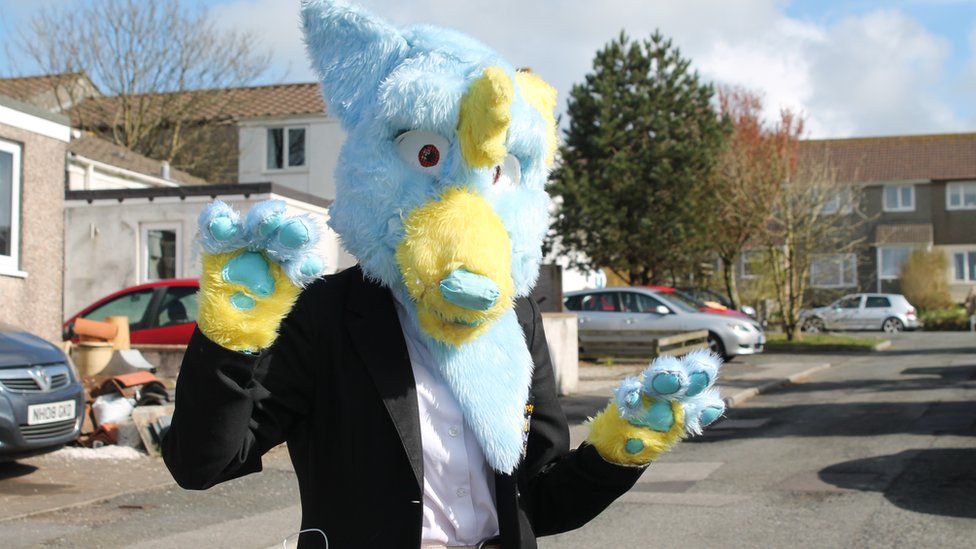 |
| Awny was Maisie's first creation and reflects her own "fursona" |
A 12-year-old girl is hoping to set up a business making furry animal costumes after realising her talent for sewing.
Maisie Earl-Tomlinson, from Four Lanes, Cornwall, has been inspired by watching fur suit parades in the United States online.
The intricate costumes take several months to make, and are part of a global sub-culture called furry fandom.
People called furries meet up online and at conventions in costumes matched to their personalities, or fursonas.
"A fursona means something personal to you so like maybe you have the same eye colour or the fur is your favourite colour or it's got the same personality as you or the same name," Maisie said.
 |
| Maisie spends most of her spare time on the sewing machine in her bedroom |
Maisie says wearing the costumes makes "you feel like a different person".
She has plans to go into business, saying: "You have a website and can sell either pre-made fur suits or people can commission you so can send you their fursona or the art that they want you to make."
Her first creation was a blue and yellow wolf that reflected her own fursona, called Awny.
She has since made a devil-dog called Caz, and is now making a "sassy fox" called Butterscotch for one of her school friends.
 |
| Maisie created 'Caz' the devil-dog (left) for Halloween and said she turned out to be friendlier than she expected |
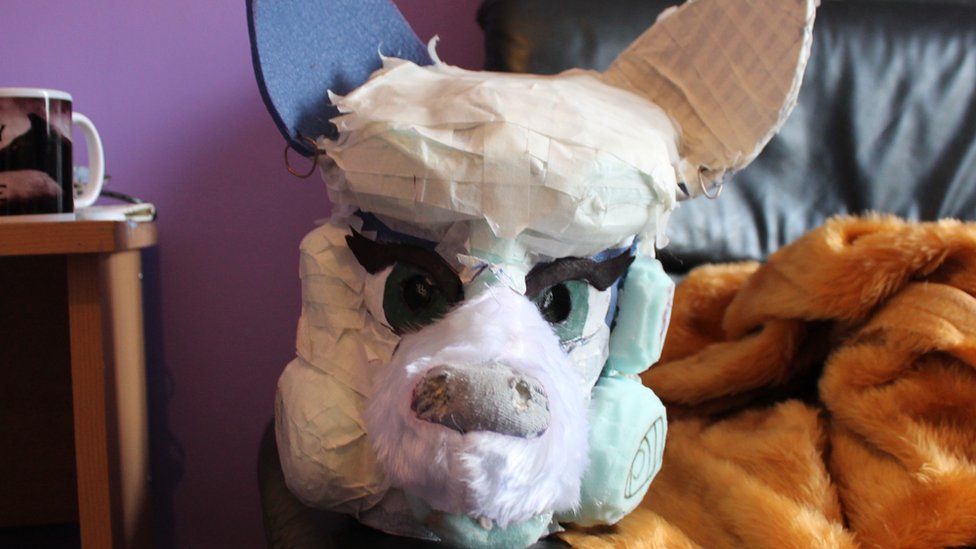 |
| She is making "sassy fox" Butterscotch for one of her school friends |
Her mother Lisa Earl said Maisie spends all of her spare time on her sewing machine: "She's completely self-taught.
"She expressed an interest in sewing so we got her a sewing machine and she's just got better and better and better."
Maisie says it is a time-consuming hobby: "Awny took me about a month.
"Caz took me about three or four months because he was more intricate and Butterscotch has taken about a month so far and will take about another three of four weeks to sew and glue all the fur on."
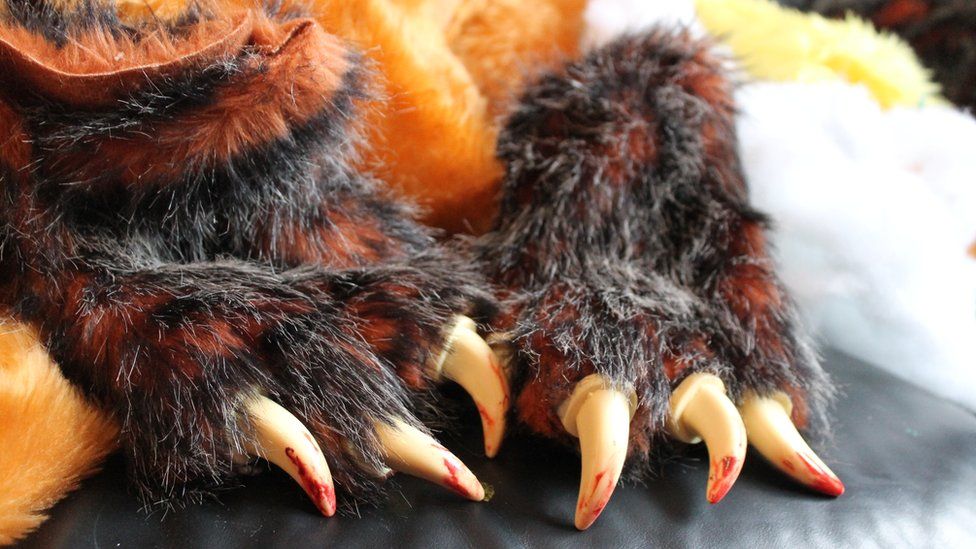 |
| The costumes consist of heads, claws, feet and sometimes sleeves |
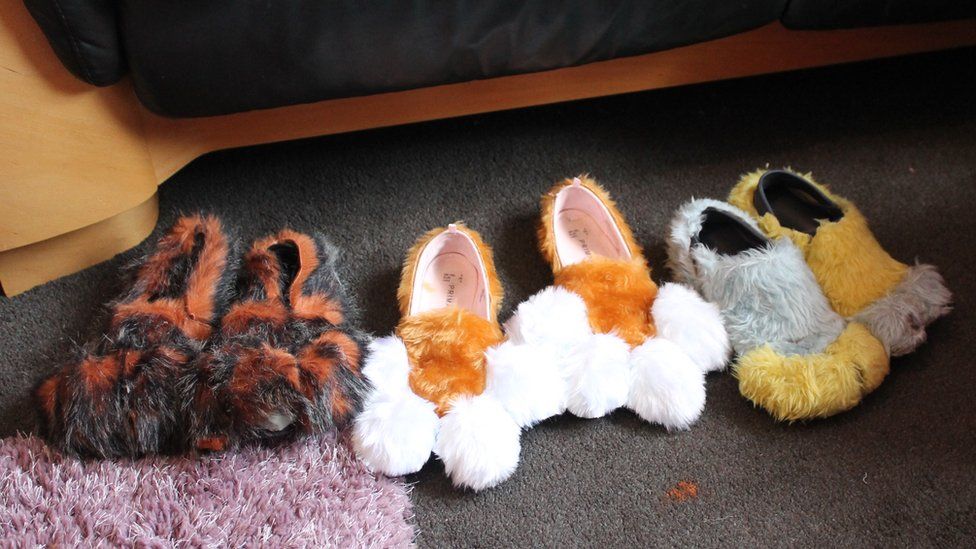 |
| They are finished off with furry feet |
* * * * * * *
What’s the Deal with “Furries?”
What a decade of research reveals about a misunderstood subculture.
Posted July 24, 2017 | Reviewed by Lybi Ma
This contribution to Animals and Us was written by Dr. Courtney Plante, a social psychologist and co-founder of the International Anthropomorphic Research Project. This is an international team of social scientists studying the furry fandom. He is also the lead author of a compendium of findings from their studies of the furry fandom. (You can read the book FurScience! here.)
Source: Photo by Douglas Muth Furries. You might know them as “the people who dress up in the giant animal mascot costumes.” Or, depending on the media you consume, you may also know them as “the people who think they’re animals and have a weird fetish for fur.” Or, just as likely, you have never heard the term “furry” before outside the context of your pet dog or the neighbor with the back hair who mows his lawn without a shirt on every Saturday. Regardless of what you have or have not heard about furries, it might surprise you to learn that there is a team of researchers who have devoted their careers to studying this fandom. Perhaps even more surprising is what nearly a decade of research on the subject can tell us all about how we relate to animals, how we understand ourselves, and how we benefit from letting the inner child run wild every so often.What are furries?Before talking about what we can learn from furries, it would be useful to have an idea of what they are, exactly. Put simply, furries are fans. In the same way that Star Trek fans are fans of Star Trek and sports fans are fans of sports, furries are fans of media that features anthropomorphic animals—that is, animals who walk, talk, and do otherwise human things. At first glance, it seems like anthropomorphic animals are a bizarre thing to be a fan of. That is until you realize that most North Americans today grew up watching Mickey Mouse and Bugs Bunny cartoons and reading books like The Tale of Peter Rabbit and Charlotte’s Web, and continue this proud tradition by taking our children to see the films like Zootopia. Sure, the intended audience of these works may be children, but the same could also be said for Star Wars and Harry Potter, a fact that has not dissuaded the millions of adult fans of these series either.
Source: Photo by Douglas Muth Demographically, the furry fandom is comprised predominantly of white males in their teens to mid-twenties. For the most part, they represent what you would expect to find in a typical geek or nerd subculture: Above-average school performance (nearly half are college students), an interest in computers and science, and a passion for video games, science fiction, fantasy, and anime.
Less typical, however, is the fandom’s LGBTQ demographics: Furries are seven times more likely than the general population to identify as transgender and about five times more likely to identify as non-heterosexual. Given this composition, it should come as no surprise that the furry fandom is a community defined in no small part by its inclusivity. This fandom embraces the norms of being welcoming and non-judgmental to all.
But aren’t furries…?Misconceptions abound about furries, with media articles routinely mischaracterizing them as fetishists or as psychologically dysfunctional people. Many such misconceptions are demonstrably false, borne often out of a lack of clear understanding about what furries do as a group. For example, the misconception that furries are people who obtain sexual gratification from wearing mascot-style fursuits stems from a small percentage of furries, approximately 20 percent, who manifest their fanship through costuming. However, as with other fan communities (e.g., video game convention attendees, anime cosplayers, sports fans who wear their team’s jersey), such costuming is rarely done for the purpose of sexual gratification and is almost always done as a form of self-expression or performance. And, like other fandoms, one’s interest in furry can manifest in a variety of ways: drawing or commissioning furry-themed artwork and writing, playing furry-themed games, costuming and performing, and gathering with others who share the same interest.Another such misconception stems from the mistaken belief that furries are not fans, but rather are people who believe themselves to be, in whole or in part, animals. In actuality, this definition better reflects a group known as Therians, whose sense of self includes non-human animals (e.g., the spirit of a wolf trapped in a human body). The vast majority of furries feel fully human and have no desire to become a non-human animal; they simply enjoy media that features animals who walk, talk, and do otherwise human things.What can furries teach us about our own psychology?Now that you have a better understanding of what furries are, and what they are not, it is worth asking what nearly a decade of research on this group can tell us about people in general. Three findings are of particular interest.1. Furries are an excellent case study for the psychological principle of moral inclusion and how it relates to non-human animals. Put simply, when something is included within a person’s moral domain, it is subject to their moral principles. In contrast, things excluded from that moral domain are deemed beyond moral consideration. Practically speaking, those who fall within our in-group tend to also fall within our moral domain, while those belonging to out-groups are less likely to gain moral consideration. In the case of furries, who spend considerable time anthropomorphizing animals, this means that many non-human animals fall within the same moral domain as people do. As such, furries are more likely than non-furries to be opposed to the use of non-human animals for commercial or research purposes.
Source: Photos by Courtney Plante 2. The vast majority of furries create a fursona—that is, a furry-themed avatar used to interact with other members of the fandom. Fursonas typically consist of one or more animal species, a name, and personality traits or other characteristics. Given the fantasy-themed nature of the furry fandom, individual furries are free to create representations of themselves unbounded by reality. As such, they can reconceptualize themselves with regard to age, gender, personality, or physical characteristics. Research has shown that most furries create fursonas representing similar, but idealized versions of themselves. Many furries report that, over time, their own self-concept tends to become more like that of their fursona. This may be due to the fact that, over time, others begin to interact with them as that idealized self, validating it and helping them to internalize it as part of themselves.
Source: Graph by Hal Herzog/Data from Courtney Plante 3. The furry world is one of fantasy, where dragons co-exist with bipedal, talking wolves and impossible hybrids. Because the world of furry content is so broad and all-inclusive, the fandom itself tends to reflect those norms. After all, if I am spending time playing pretend as a neon-blue cat that walks and talks, am I in any position to judge you for what you wear or how you choose to identify? To this end, many furries describe the fandom as one of the first places where they felt like they could belong, something that needs to be contextualized with the fact that furries are about 50 percent more likely than the average person to report having been bullied during childhood. For most furries, the fandom is about more than just indulging a child-like fantasy every once in a while. It is about forging lifelong friendships and building a social support network in a community who will not judge them for having unconventional interests. So while most of us would look at a person who watches cartoons or costumes as an anthropomorphic dog, wondering: “What’s wrong with that person?” The data suggest that these very same fantasy-themed activities are a fundamental part of that person’s psychological well-being.
Perhaps the most fascinating thing that a decade of research on furries can tell us is that, in the end, furries are no different than anyone else—they have the same need to belong, need to have a positive and distinct sense of self, and need for self-expression. Furries, in other words, are just like you—but with fake fur!Click here for a list of publications on furries by the International Anthropomorphic Research Project. Dr. Courtney Plante can be contacted at cplante@uwaterloo.ca



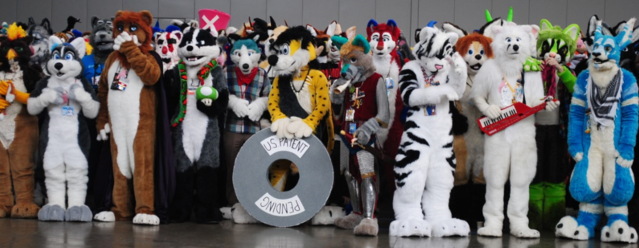

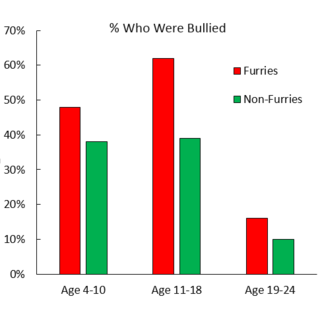
No comments:
Post a Comment